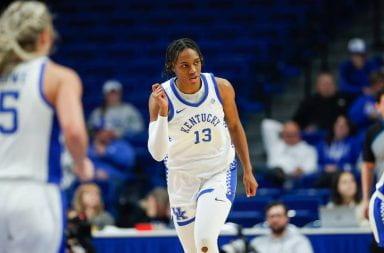Since the city of Columbus lacks an International House of Pancakes restaurant, Ohio State students must turn elsewhere to satisfy their breakfast food cravings.
“I go to Waffle House six times a month,” said Gordon Rankin, a second-year in math education. “If an IHOP were built, I would definitely fill those Waffle House spots with IHOP.”
According to the restaurant’s Web site, there were 1,433 IHOPs in the U.S., Canada and Mexico by Sept. 30, 2009.
Scott Womack, an IHOP franchisee since 1988, founded Womack Restaurants in Terre Haute, Ind., and has eight IHOP restaurants.
An IHOP press release from July 20, 2006, said that Womack had “agreed to develop 17 new IHOP restaurants over the next 12 years in the Dayton and Columbus, Ohio, markets.”
The Womack Restaurants Web site said the development plan totals 25 new IHOP restaurants, and that the company owns the franchise rights to 33 counties surrounding Dayton and Columbus.
“Columbus is a big market and we’re working hard to get an IHOP there,” Womack said in a phone interview March 5. “Right now we’re looking for real estate; that’s the first step.”
Despite the affirmation that there will be an IHOP in Columbus, Womack wouldn’t reveal where the restaurant would be located or how soon it would arrive.
“We had a problem getting credit for new construction equipment,” he said. “We also switched to a smaller bank as our old bank was on lockdown because of the state of the economy.”
Womack opened the first Ohio IHOP in Chillicothe October 2008, and the second in Lancaster September 2009. The Chillicothe IHOP is an estimated 59-minute drive from Columbus and the Lancaster IHOP an estimated 38-minute drive.
“We do a comprehensive evaluation of all trade areas and go to the top 12 areas we know will be successful,” Womack said.
While it seems that Columbus would be a “top 12” area to build a restaurant, there are other factors that play into the building process.
“It’s a waiting game. You have to wait until the real estate becomes available,” Womack said. “Vacant lots are extremely frustrating because most of the time someone has already bought them.”
Many students are unaware that Columbus used to be home to a handful of IHOP restaurants. The Little Bar, located at 2195 N. High St., is one of those places.
Jim Early was a student at OSU from 1976 to 1981. Today he runs columbusrestauranthistory.com, where he shares information about many different restaurants that used to be located in Columbus and what the buildings have become today. Early remembers the IHOP located at 2195 N. High St. since he used to eat there as a student.
“From my research, I know the building was built in 1966 and I’ve found newspaper ads from as early as September 1971,” he said. “I can’t remember exactly when it closed, but I’ve seen newspaper ads from as late as May 1982. The property was transferred in March 1987.”
Early said there were two other IHOP locations in Columbus during the 1980s. He believed they were situated on Main Street and Morse Road.
Students have some disagreement over where a new IHOP restaurant should be placed. The majority, including Rankin and third-year journalism major Zachariah Jones, think it would be best in a suburb of Columbus.
Worthington, a suburb on the north side of Franklin County, is the ideal location because it’s close to home, said Jones.
The Hilliard area on the northwest side of Franklin County would still get a pool of OSU students as well as customers from the surrounding area, more so than an IHOP in the Reynoldsburg area on the east side would see, said Rankin.
But Marina Tripodis, a fourth-year in communication, feels that a location closer to campus would fit. Tripodis has worked at Hang Over Easy, a popular campus breakfast eatery located at 1646 Neil Ave., for the past two and a half years.
Jones said he hopes that a local IHOP would appeal to a “younger, college-specific crowd,” and take away business from Bob Evans and Waffle House.
“When I go to Bob Evans I feel like I’m eating with a bunch of senior citizens and when I eat at Waffle House I feel like I’m eating with a bunch of truckers,” Jones said. “Which is OK at 3 a.m., but not other times.”
With the impending IHOP reappearing in Columbus, local business owners must consider what effects it could have on their breakfast restaurants.
Nick Pedro has owned his establishment for a total of eight years. It
was known as “Nick’s Diner” for five years before changing its name to the more original “Hang Over Easy” in spring 2007, said Pedro.
Pedro isn’t worried about the possibility of an IHOP settling nearby and said that his restaurant’s biggest competition comes from the student dining centers on campus.
“We don’t worry about others. We let them do what they do,” Pedro said.
Even with the knowledge that IHOP is open 24/7 and could attract late-night students, Pedro said the idea of Hang Over Easy staying open through the night “has not really been explored.”
“It depends on how close the IHOP is to us,” Pedro said. “We tried a 12 a.m. to 4 a.m. shift for a few months but didn’t have enough business. Plus customers have the tendency to destroy things if they’re drunk, so it’s just not good to stay open late.”
Some Columbus residents would be satisfied without the addition of an IHOP.
Nick Dekker is a theatre department lecturer at OSU and has been writing a blog for three years titled “Breakfast with Nick.”
“I’m a morning person and enjoy starting my day with breakfast,” Dekker said. “Columbus is a great breakfast city.”
The former Michigan resident has reviewed 30 breakfast restaurants in central Ohio, and said he would be “perfectly fine” without an IHOP in Columbus.
“I have nothing against IHOP. I just like the local, unique places,” said Dekker. “These little places are doing well despite all the Bob Evans and Waffle Houses around, so I have no fear for their business. People go toward what they’re attracted to.”
While Dekker has no fear for the smaller businesses, Womack has no fear his IHOP would not be a “solid player” in the Columbus market.
“We’re a proven brand and people love us, judging by the amount of e-mails and letters we get from customers,” said Womack. “In a sense, we’re like Coke and Pepsi. Both are competitive but both are appreciated.”


